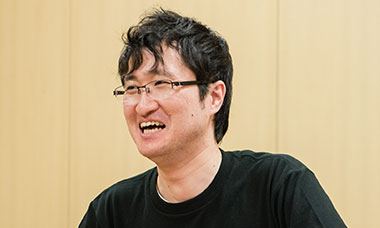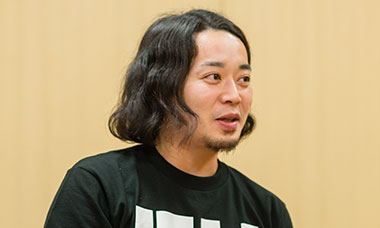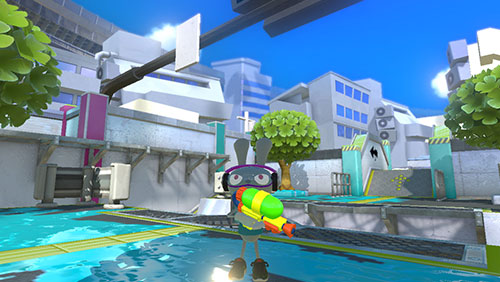What was it that led you to choose the tofu game out of seventy ideas?
I think having that prototype to play with was a big factor.
From the prototype, you were able to play four against four in an online match.
You could play four on four from the beginning? Programmers are amazing.(laughs)
(nods happily)
They say that programmers are the best when it comes to making a new game structure.
That’s true. (laughs)
I used this technique a lot myself, because I used to be a programmer, too. (laughs)
(laughs)
And Sato-san’s prototype already had a really strong basic playing structure. It was the opposite of the way it is now. The map was on the TV screen, and you controlled the 3D screen of your tofu moving on the Wii U GamePad. You kept track of your opponent’s movements on the map, shot ink from the tofu, and claimed your turf. It was so much fun and I thought, “This could be the core gameplay.”
How did the ink come out of the tofu?
We gave the tofu a little nose. Otherwise you’d never know which end was the front or the back. (laughs)
That’s true. Tofu doesn’t have a front or a back. (laughs)
So the ink came out of the nose. (laughs)

(laughs)
Sato-san, when you thought up this project, what did you think was the most important point?
The first point was the idea of “hiding.” The map screen at this time was the kind where you simply look at the 3D environment from a top-down perspective, so when the tofu slid on top of the ink, it blended in so you couldn’t see it.
Sort of like camouflage colours. It would become invisible.
That’s right. But in a 3D environment, you could see where you were because the tofu was standing, so we added the movement where you could lay low.
The final result was a squid able to dive in the ink, and that came from the idea of hiding.
Right. Tofu is a bit of a hard sell, so we decided to turn the characters into something humanoid.
So we designed a character with arms and legs, but we came up with something that sacrificed the original uniqueness of the game.
When it was tofu, you couldn’t see your tofu on the map when it was in the ink. But when the character became a human, you could vaguely see that there was someone there…
But then there was no point in hiding anymore.
That’s right. Not being able to see anyone hiding in the ink, or being vaguely able to see someone there completely changes the point of the game.
If your enemy can’t see you at all, you can do things like ambush or attack covertly. And then, when you head into an area covered with your enemy’s ink, you think, “There might be an enemy hiding here.” You need to be really vigilant, so it really gives a sense of tension to the game.
So for the game to work, we needed the characters to disappear completely. And although it was a great idea to add some depth to the arena to enrich the experience, it all started to come undone after that.
The rule of the game is that the winner is decided by how much of the area on the map they’ve inked when the map is seen from a top-down-perspective. However, when we gave the arena depth, we ran into the problem of “what’s the point of inking the walls, then?”
I see. Even if you inked the walls, you couldn’t see it on the map from the top-down-view, which took away the meaning of being able to ink walls.
Even if you worked hard to ink the walls, it didn’t help you win. So for a while we took away the ability to ink the walls.
But that took some of the fun out of playing. We had a round of discussions as to whether the player should be able to ink the walls or not.

That’s true. After we made the characters human and added depth to the arena, things did start to fray a bit. We weren’t sure how to solve those problems.
We were struggling, even beyond trying to solve those issues.
We even talked about turning them back into tofu.
But then we thought, “How many copies could we sell with tofu?”
I don’t think tofu would have really worked…
(laugh)
By the way, one of our options was to make the character Mario.
Over ten years ago, we had a game called Super Mario Sunshine11. A unique element of the game was using a pump to spray water. Did this game come to mind?11. Super Mario Sunshine: A 3D action game released for Nintendo GameCube in October 2002 in Europe. The game revolved around the use of water, including a pump worn on Mario’s back, which would spray water.
We get asked that a lot…
Is there any connection?
I forgot about it…
(laughs)
We only remembered it later on. Like, “Oh yeah, there was a water gun in Super Mario Sunshine.” As Nintendo employees, that’s pretty embarrassing. (laughs)
But the structure of the game is completely different, after all. And this wasn’t an idea that could have come from Super Mario Sunshine.
Right. We wanted to come up with the play structure from scratch and then create a design to match the structure. So we didn’t really want to borrow a pre-existing character.
So how did you find a way out of your struggle?
We tried switching the character from humans to rabbits.

Why a rabbit?
Well, a lot of it was because of design factors. Rabbits are white to begin with, so it would be easy to tell if they were inked. They’ve got long ears that would move when they did, so you could see them moving and when viewed from above, it would be easy to tell which direction they were facing by the direction of the ears.
And when asked which character they would choose for our new game, a rabbit or tofu…
Everyone would say rabbits. (laughs)
Right. (laughs)
(laughs)
© 2024 Nintendo.